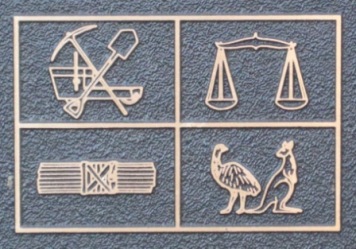William Dexter

Contents
Background
William Dexter was a china painter who was born in Devon, England. He married Caroline. Dexter sailed for Australia in 1852, and was joined by his wife in 1854.
Goldfields Involvement, 1854
Goldfields unrest and agitation against what was seen as an unjust Gold License fee centred in Bendigo in 1853. Large gatherings of diggers took place in Bendigo over the course of August 1853. Over 10,000 people welcomed the petition representatives back to the diggings on 13 August, assembled under the Diggers’ Flag, designed by William Dexter.[1] The flag's design included a pick, shovel and cradle representing the labour of the miners, the scales of justice, an ancient Roman bundle of sticks signifying unity, as well as uniquely Australian fauna the kangaroo and emu.
Dexter urged Bendigo miners to wear a red ribbon as a sign of protest against the mining tax. This became the symbol of the Red Ribbon Rebellion.
'But Eureka was only one manifestation of the Chartist inheritance upon the goldfields, and this chapter goes back to the Bendigo fields in the southern winter of 1853, where Chartists such as Henry Holyoake, George Thomson and William Dexter played a central role in organising the 'red-ribbon' protest against the thirty-shilling monthly miner's license.'[2]
Post 1854 Experiences
See also
Further Reading
References
- ↑ http://www.egold.net.au/biogs/EG00240b.htm, downloaded 15 March 2013.
- ↑ Illustration 14 of Thomson is taken from Cusack, Bendigo, opposite p. 36.; Andrew Charles Messner, PhD, Chartist Political Culture in Britain and Colonial Australia, c. 1835-1860, Messner, Andrew Charles (author); Atkinson, Alan (supervisor); Kent, David (supervisor); Prothero, Iori (supervisor), UNE, 2000.